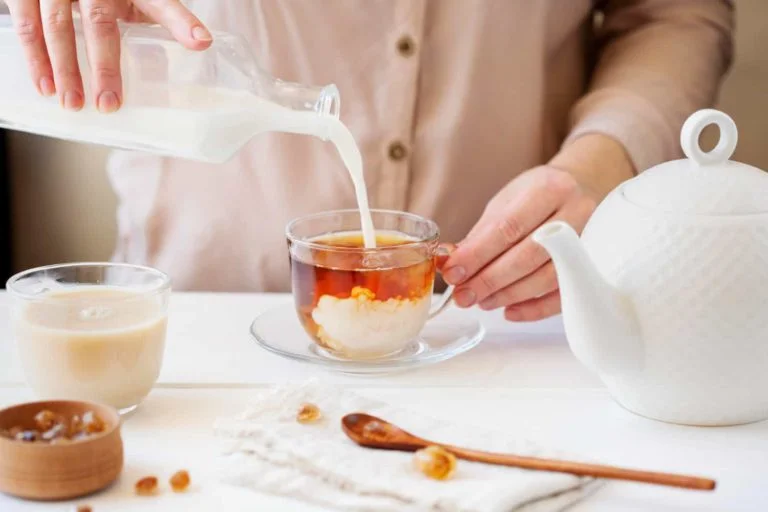8 Mistakes You’re Making When Brewing Herbal Tea
Brewing herbal tea seems simple, but there are some common mistakes people make that can lead to bitter, lackluster tea.
In this article, we’ll go over the top 9 errors to avoid for flavorful herbal tea every time. Making these small tweaks to your brewing method can reveal the full aromatic and healthy potential in each herbal tea blend. Read on to transform your herbal tea experience!
Key Points for Proper Herbal Tea Brewing

This article will cover the following main steps for brewing flavorful, aromatic herbal tea:
- Use Pure Water – Filtered or spring water allows true flavors to shine.
- Preheat the Vessel – Maintains optimal steeping temperature.
- Follow Steeping Guidelines – Herbs need specific temps and times.
- Handle Leaves Gently – Avoid over-agitating to prevent bitterness.
- Store Tea Properly – Refrigerate in a sealed container for freshness.
- Use Quality Loose Leaf – Whole leaves have superior flavor.
- Check Out the Recipe – See proper technique implemented in a soothing chamomile mint tea.
By learning these key aspects of brewing and avoiding common errors, you can unlock the full potential of flavors, aromas, and health benefits in herbal teas. Master these fundamentals for a perfectly infused cup anytime.
Let’s explore each of these tips in detail. Proper technique makes all the difference when it comes to creating an amazing herbal tea experience…
Understanding Herbal Tea Brewing Terminology
When learning about herbal tea brewing, you’ll encounter some specific terms used to describe the processes and compounds involved. Here are quick definitions of some key words:
Tannins – These are naturally present, mildly bitter plant compounds found in tea leaves, seeds, bark, and stems. A small amount of tannins adds depth, but too much causes an astringent, drying mouthfeel.
Infusion – The process of steeping tea leaves in hot water to extract flavors, oils, colors, and health compounds. Proper infusion is key to robust herbal tea.
Phenols – Also called polyphenols, these are plant-based micronutrients in tea associated with health benefits. However excessive phenols can also cause bitterness.
Catechins – A type of natural phenol antioxidant found specifically in green and white teas. Catechins provide many of the health benefits of those teas.
Oxidation – Chemical reactions when tea leaves are exposed to oxygen, impacting the flavors and aromas. Black tea is fully oxidized while green tea undergoes minimal oxidation.
Volatile Oils – Fragrant, aromatic compounds in tea that vaporize quickly when heated. Knowing oil volatility guides proper steeping methods.
Understanding these and other technical brewing terms will help demystify the steps to achieving the perfect cup of herbal tea.
1. Not Using Filtered Water:
Why Tap Water Alters Herbal Tea’s Flavor
- Mineral Content Clashes With Delicate Flavors
- The minerals in tap water can overpower the subtle flavors of herbal tea. Herbal flavors are delicate and can easily be distorted.
- Chlorine Causes Metallic Tastes
- The chlorine used to disinfect tap water imparts unpleasant metallic flavors. This clashes with herbal tea’s light, fruity, floral notes.
- Magnesium & Calcium Make Tea Taste Bitter
- The magnesium and calcium content in tap water makes herbal tea taste overly bitter and harsh.
Use Purified or Filtered Water for Best Flavor
- Purified Water
- Purified water has had all impurities and minerals removed to leave pure H20. This allows the true flavors of the herbal tea to shine.
- Filtered Water
- Filtered water removes chemicals like chlorine but leaves some beneficial minerals. A smooth, clean-tasting option.
- Spring Water
- Naturally filtered by the earth, spring water contains some minerals but in lower amounts than tap. Try spring as well to see which water allows the herbal flavor to come through.
- The purest taste comes from using purified, filtered, or spring water. Avoid tap water with its high mineral content that distorts delicate herbal tea flavor.
2. Why Failing to Preheat Hurts Steeping
- Cold Teapots Draw Out Heat
- When you add hot water to a cold vessel, the heat is rapidly lost to the cold walls of the pot or cup.
- Leads to Lower Steeping Temps
- This drop in temperature prevents the herbs from properly releasing their flavors, colors, and health compounds into the water.
- Herbal Tea Comes Out Weak and Pallid
- Tea steeped at too low of a temperature will be weak, pallid, and lacking the vivid aromas and flavors desired.
Always Preheat Your Vessel
- Discard the Hot Water After Preheat
- Heat your teapot or cup with hot water first, then discard this before adding your herbs.
- Maintains Optimal Steep Temp
- This preheating means the water will maintain the ideal temperature as the herbal tea steeps.
- Results in Properly Infused, Vibrant Tea
- Following this step leads to a vibrant, aromatic, and optimally infused cup of herbal tea.
3. Brewing Herbal Tea at the Wrong Temperature
- Each Herbal Tea Needs a Specific Steeping Temperature
- Steeping at the Wrong Temperature Causes Issues.
- Too Hot: Bitter, Astringent Flavor
- Excessively hot water scalds the leaves, releasing bitter tannins.
- Too Cold: Weak, Dull Flavor
- Water that is too cool prevents the full release of flavor compounds.
- Use a Thermometer for Precision
- Take the guesswork out and use a thermometer to hit the optimal temp for each herbal tea.
- Brewing at the proper temperature is crucial for coaxing the full flavor and health benefits of each unique herbal tea blend. Follow specific temperature guidelines for amazing tea every time.
| Herb Type | Steeping Temperature |
| Delicate (chamomile, lemon balm, mint) | 160°F – 175°F |
| Standard (hibiscus, rosehip, rooibos) | 175°F – 195°F |
| Robust (ginger, dandelion, turmeric) | 195°F – 212°F |
For example, delicate herbs like chamomile and mint used in our recipe need lower temperatures around 170°F and shorter steeping times of 3-4 minutes.
Soothing Chamomile Mint Tea

This calming blend highlights proper herbal tea brewing methods for a perfect cup.
Ingredients:
- 1 Tbsp loose-leaf chamomile flowers
- 1 Tbsp fresh mint leaves
- 8 oz filtered water
Brewing Instructions:
- Boil filtered water in a kettle or pot. Remove from heat once boiling.
- Preheat a teapot by rinsing it with hot water. Discard water.
- Add chamomile flowers and mint leaves to the pot. Pour hot water over top. Water temperature should be around 170°F, ideal for delicate herbs.
- Allow to steep for 3-4 minutes. Use a timer for best results.
- Gently press the tea leaves with a spoon before pouring to release the liquid without over-squeezing.
- Pour the tea through a fine mesh strainer into teacups.
- Enjoy the bright, aromatic flavors of this soothing herbal tea!
Follow these proper brewing steps to create a perfectly smooth, flavorful cup of chamomile mint tea anytime. Adjust the recipe with your favorite herb combinations and proper techniques.
4. How Long Can You Steep Herbal Tea
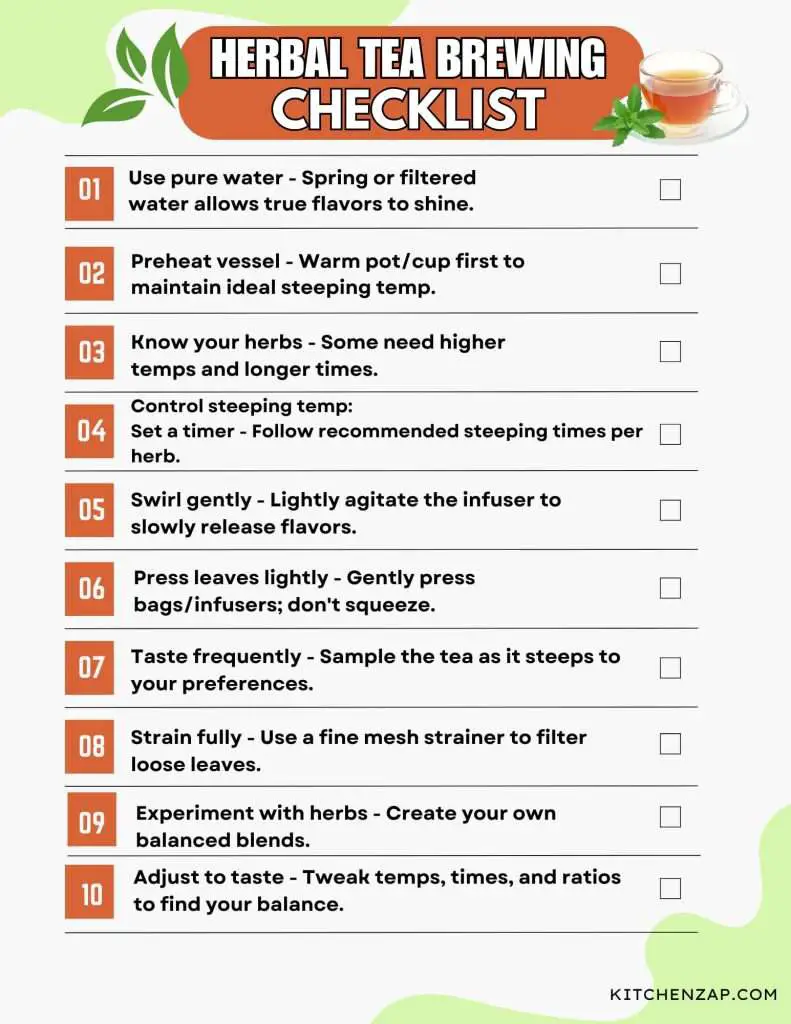
- Steeping Herbal Tea Too Long Causes Bitterness.
- Tannins Build Up Over Time
- The longer the tea steeps, the more bitter tannins are released from the leaves.
- Bitterness Overpowers Delicate Flavors
- Excess tannins create an unpleasant bitter, astringent flavor.
- Follow Recommended Steeping Times.
- Delicate Herbs: 3-5 minutes
- Standard Herbs: 5-6 minutes
- Robust Herbs: 8-10 minutes
- Steeping longer than recommended releases too many tannins
- If Re-steeping, Use Shorter Times.
- Monitor Color as Well as Time
- Note when the herbal tea reaches your desired hue and strength
- Steeping herbal tea for the precise recommended time prevents over-extraction while allowing full flavor and healthy compound extraction.
5. Using Low Quality Herbs
- Fresh, Whole Herbs Make Better Tea.
- Dry vs Fresh Herbs
- Dried herbs lose some volatile oils but are more convenient
- Fresh herbs offer the fullest flavor and aroma when available.
- Whole Leaves vs Broken Pieces
- Whole leaves contain more essential oils than broken leaves
- But broken leaves infuse faster since water access is easier.
- Tea Bag vs Loose Leaf
- Tea bags contain lower-quality broken leaves and dust
- The loose-leaf contains whole, intact leaves for the fullest flavor.
- Recommendations for Best Quality Herbs
- Seek out “loose leaf” over bagged herbal tea
- Choose brands that use full leaves not dust or fannings
- Buy from reputable sellers known for quality tea
- Store in airtight opaque containers away from air, light, and moisture.
- Higher quality, freshness, and proper storage preserve the complex flavors and aromas of fine herbal teas. Drink them as close to harvest as possible.
6. Agitating the Infuser Too Much
- Why Agitation Causes Problems:
- Aggressively handling the infuser breaks up the tea leaves, releasing more bitter tannins
- Tannins are naturally present in the tea leaves and provide some flavor, but excess tannins taste harsh and astringent.
- Effects of Excess Tannins:
- Overly bitter, drying, puckering flavor
- Astringency overpowers the delicate herbal flavors
- Health benefits are diminished by interference from excess tannins.
- Recommended Gentle Handling:
- Gently swirl the infuser to equally infuse all leaves
- Lift the infuser only 1-2 times to allow water flow between leaves
- Never squeeze, twist, or compress the infuser
- Allow hot water to passively and gently extract flavors.
- Avoid aggressive handling that damages leaves and forces excess tannins into the tea. The key is gentle motion just enough to allow water flow without crushing leaves. Let the hot water passively draw out the herbal essences for smooth flavor.
7. Squeezing Tea Bags

- Why Squeezing Causes Problems:
- Pressing, squeezing, or twisting tea bags forces out excess tannins and polyphenols
- These compounds are bitter, and astringent, and overpower the tea’s flavor.
- Effects of Over-Squeezing:
- Unpleasant bitter, puckering flavor
- Increased astringency dries out the mouth
- Abrasive, harsh taste overpowers the delicate herbal flavors.
- Recommended Handling:
- Gently press the tea bag once with a spoon to release the liquid
- Never twist, wring, or squeeze the tea bag
- For loose-leaf tea, gently lift the infuser 1-2 times only.
- Avoid squeezing or compressing tea bags. Use a gentle touch to lightly press bags and release liquid. Squeezing forces harsh compounds into the tea, diminishing the delicate flavor.
8. How Long Does Brewed Herbal Tea Last in the Fridge
- Improper Storage Degrades Flavor.
- Exposure to Air:
- Oxygen can cause flavor deterioration and nutrient breakdown.
- Exposure to Light:
- Light accelerates the oxidation process, ruining the flavor.
- Temperature Fluctuations:
- Heat and cold accelerate the degradation of aromas and oils.
How long does brewed herbal tea last in the fridge?
- Recommended Fridge Storage Time:
- Up to 5 days refrigerated is safe for most herbal teas
- Transfer to an airtight container after brewing
- Keep stored tea in the back of the fridge
- If mold appears, discard it immediately
- For Maximum Freshness:
- Drink soon after brewing and avoid refrigerating multiple days
- Store any leftovers in a sealed container
- Place in the coldest part of the fridge.
Properly storing brewed tea preserves the flavor and aromas. Drink herbal tea soon after brewing for the absolute best taste.
Herbal Tea Brewing Checklist
☑️ Use pure water – Spring or filtered water allows true flavors to shine.
☑️ Preheat vessel – Warm pot/cup first to maintain ideal steeping temp.
☑️ Know your herbs – Some need higher temps and longer times.
☑️ Control steeping temp:
Delicate herbs: 160-175°F
Standard herbs: 175-195°F
Robust herbs: 195-212°F
☑️ Set a timer – Follow recommended steeping times per herb.
☑️ Swirl gently – Lightly agitate the infuser to slowly release flavors.
☑️ Press leaves lightly – Gently press bags/infusers; don’t squeeze.
☑️ Taste frequently – Sample the tea as it steeps to your preferences.
☑️ Strain fully – Use a fine mesh strainer to filter loose leaves.
☑️ Store properly – Sealed, opaque container in the fridge.
☑️ Experiment with herbs – Create your own balanced blends.
☑️ Adjust to taste – Tweak temps, times, and ratios to find your balance.
FAQs about Brewing Herbal Tea
- What is the ratio of herbal tea to water?
The standard ratio is 1 teaspoon of dried herbs or 2 teaspoons of fresh herb leaves per 1 cup of water. However, this proportion can vary based on personal taste preferences and the type of herbs used.
Robust herbs like ginger and cinnamon tend to be used more per cup, while lighter herbs like lemon balm and chamomile are used less. Always start with the basic ratio, then adjust the amount of herbs upwards or downwards to achieve your ideal strength.
Use more herbs for a concentrated, strong herbal tea, or reduce the amount for a milder brew. Play around with different herb-to-water ratios to find the optimal balance.
- How long do you boil water for herbal tea?
The proper technique is to bring fresh cold water to a rapid rolling boil, then immediately remove it from the heat. Allow the water to sit for a minute or so before steeping herbs. Do not actually boil the herb leaves themselves, as this can diminish their volatile essential oils.
As soon as the water reaches a boil, take it off the stove and wait a brief moment for any bubbling to settle before pouring it over your prepared herbs. This ensures the water is sufficiently hot to properly infuse the teas while avoiding boiling the leaves directly.
- What happens if you oversteep herbal tea?
Overly steeping herbs for longer than the recommended time results in excess tannins being released into the tea. Tannins are naturally occurring bitter and astringent compounds found in the leaves.
A small amount adds depth, but too much leads to an unpleasant mouth-puckering, overly bitter flavor. Additionally, steeping too long can draw out unwanted vegetal, grassy qualities.
Follow the recommended steeping time per tea type, testing frequently until the herbal tea reaches your optimal strength and flavor. It’s easy to overextract herbal tea if left steeping too long.
- Can I add milk or sugar to herbal tea?
Yes, it is common for many people to enjoy complementing the light, delicate flavor of herbal teas with milk, honey, sugar, or other sweeteners. The key is to first taste the freshly brewed tea on its own to determine if any additions are needed.
Avoid prematurely reaching for milk or sugar before understanding the tea’s inherent flavor. If you desire a touch of sweetness or creaminess, add conservatively.
Agave, stevia, and maple syrup provide sweetness without overpowering herbal subtleties. Non-dairy milk also pairs well. Always enhance the existing flavors instead of masking them.
- What are some popular herbal tea blends?
There is a wide range of single herb and blended herbal tea options to suit any palate. Common single-herb teas include chamomile, peppermint, ginger, licorice, hibiscus, rooibos, and green tea.
Popular blends feature creative combinations like Lemon Zinger (lemongrass, hibiscus, peppermint), Sleepytime (chamomile, spearmint, lemongrass), Tazo Zen (green tea, lemon grass, spearmint), Throat Comfort (licorice root, slippery elm bark, cinnamon).
Experiment with different herbs and custom blends to find your favorites. The possibilities are endless when crafting herbal tea!
Conclusion
Making herbal tea seems simple, but avoiding these common mistakes can elevate your cup to the next level.
Follow these tips to draw out the fullest flavors and health benefits from your herbal tea:
- Use purified or filtered water to allow flavors to shine
- Always preheat your vessel before steeping
- Know the ideal steeping temperature for each blend
- Steep for the recommended time only
- Gently handle the tea leaves or infuser
- Never over-squeeze tea bags
- Store properly in an airtight container in the fridge
- Choose high-quality loose-leaf herbs when possible
With the proper techniques, you can unlock the aromatic, flavorful, and healthy properties of herbal tea. Avoid bitterness and muted flavor by steeping at the right temperature and time. Use spring or filtered water for pure taste.
Perfect your herbal tea ritual and enjoy a sensory experience in each soothing cup. Follow these brewing tips for smooth, robust, perfectly infused herbal tea every time.
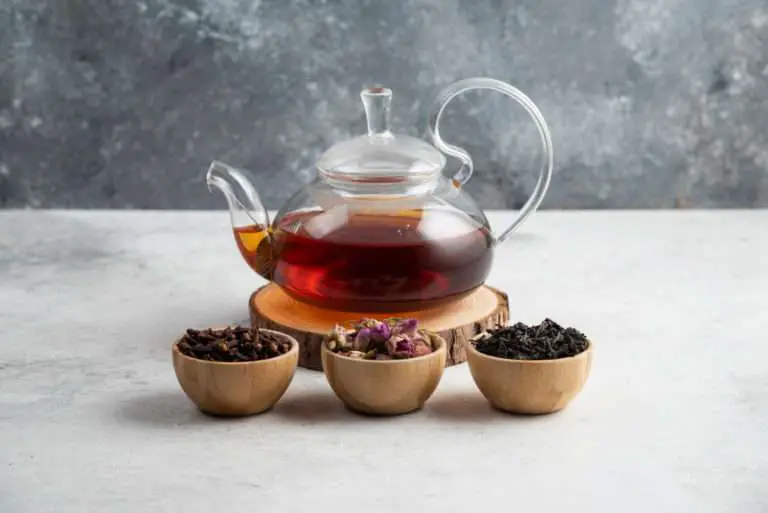

![How to Brew Assam Black Tea – A Quick and Easy Guide [+Recipes] 10 How to Brew Assam Black Tea – A Quick and Easy Guide [+Recipes]](https://kitchenzap.com/wp-content/uploads/2021/06/Assam-Tea-Brewing-Time-768x512.jpg)
